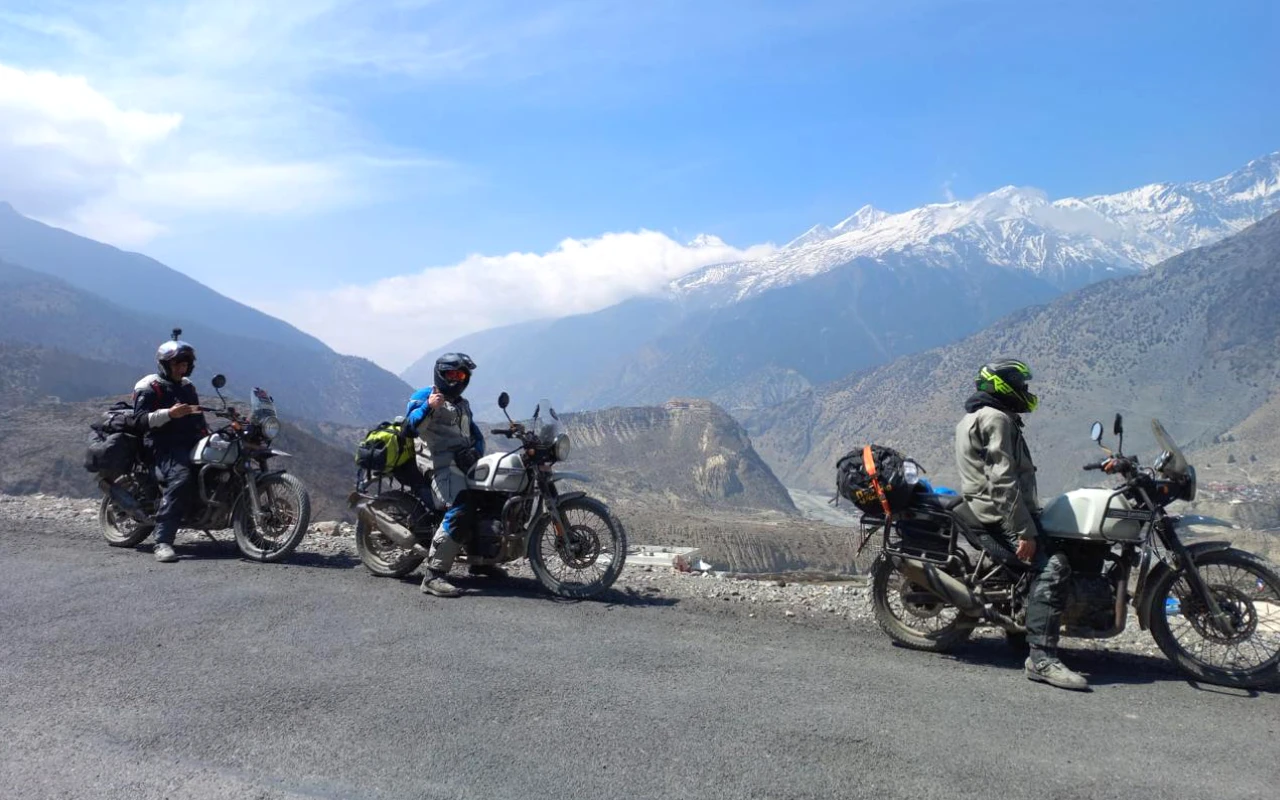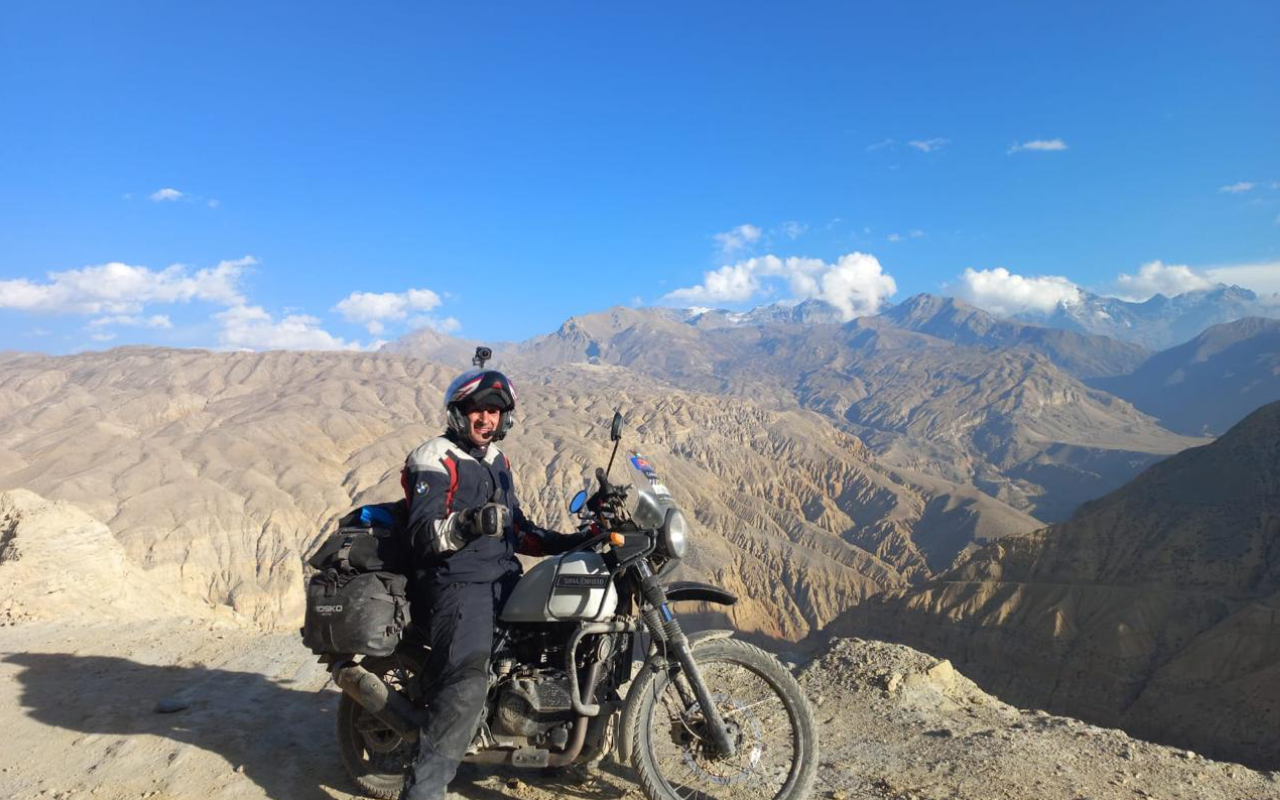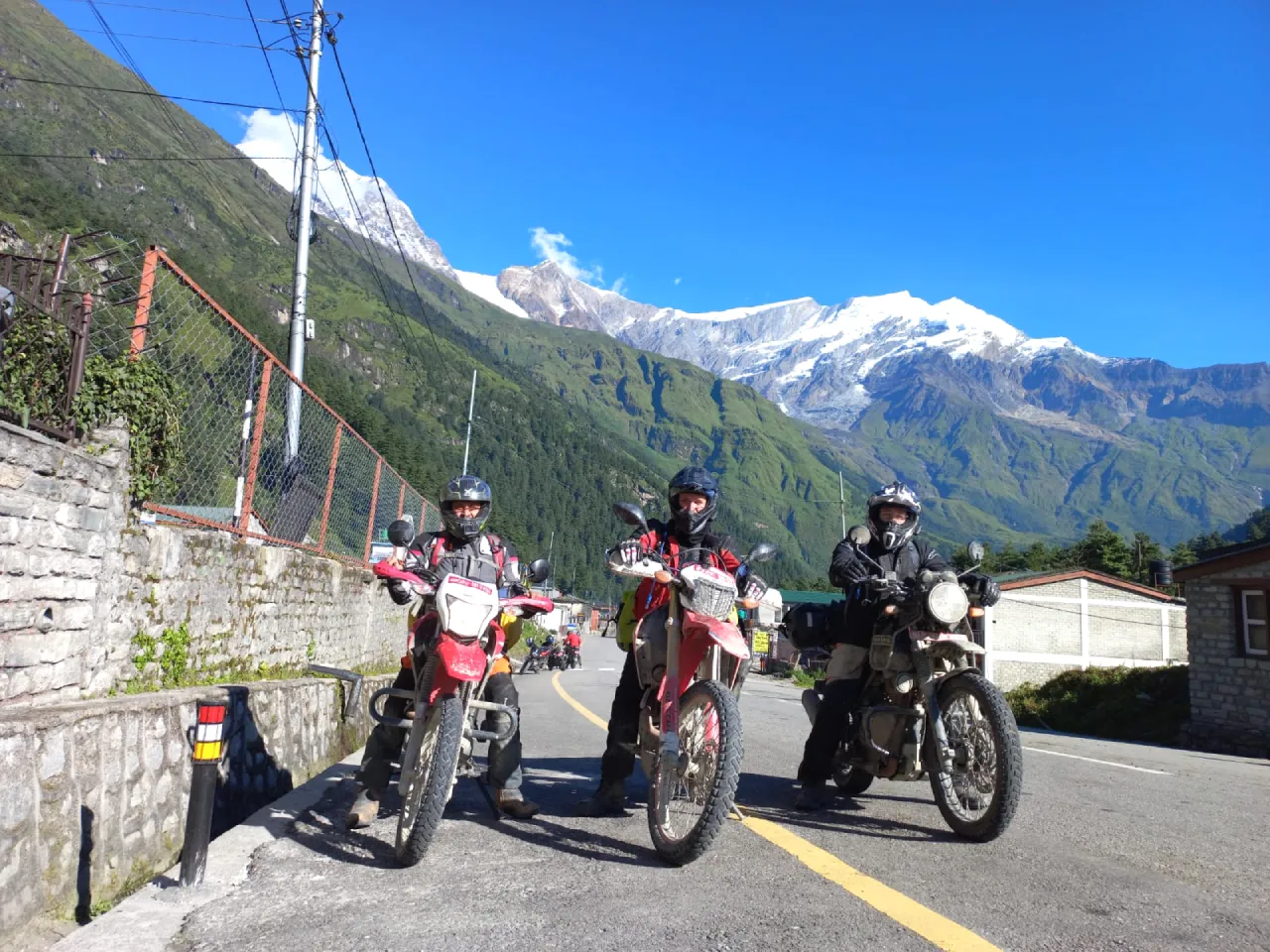Upper Mustang is an eye-catching place in Nepal that is known for its ancient Tibetan culture, rugged landscapes, and remote Himalayan views. Motorcycle tours are a dream come true, offering breathtaking scenery and cultural encounters throughout one to two weeks.
The preserved Tibetan culture and geography make the Upper Mustang special. There are many ancient monasteries, sky caves, and traditional villages that display a blend of Tibetan and Nepalese cultures. The landscape itself is just as dramatic, with towering Himalayan peaks, gorges, and desert temperatures that would challenge the best riders and excite adventure seekers.
Riding in Upper Mustang is about the adventure factor, not just the riding, but having to deal with rough roads, high passes, climbing rough and sometimes unprotected ledges. Additionally, it entails ascending and descending from isolated routes, providing a chance that few tourists get to enjoy. You will have to get to know the warm and hospitable mountain people while having the opportunity to witness the way of living that remains unchanged for many generations.
This is the complete guide to prepare for an Upper Mustang motorcycle tour. It will include all necessary permits, suggested routes, and helpful tips. If you are a competent motorcycle rider or an enthusiastic adventure seeker, this guide will prepare you for an exciting journey into one of Nepal’s most exclusive and amazing regions.

Why Choose Upper Mustang for a Motorbike Tour?
The allure of Upper Mustang lies in its being a restricted zone, making certain aspects of its unique culture mostly untouched by the modern world. For travelers, the region offers an oasis into a Tibetan Buddhist past, ancient monasteries, and lifestyles that have retained their original integrity for centuries.
The area is also a great adventure away from the beaten path, a combination of Tibetan culture and stark deserts. As riders transition from the lush river valleys of Nepal into an arid plateau, they encounter remote villages, the ancient trade routes that link Tibet and Nepal, and all of the history that accompanies that trek of cultures.
Upper Mustang is motorcycling terrain, though challenging, with rough roads, rocky tracks, and high-altitude passes, which will allow for adrenaline-packed rides. Skilled riders will gain extraordinary Himalayan views, mountain pass gorges, and the allure of exploring some of the least explored and purest areas in Nepal.
Upper Mustang is an opportunity for a motorbike tour that combines adventure with cultural discovery. It will be a unique experience, which embraces being in a highly restricted region while engaging with living Tibetan traditions, rugged landscapes, and a motorcycle adventure. All of this adds to the unique experience that blends the excitement of exploration with the chance to interact with a living cultural museum.

Permits You Need for Upper Mustang
All foreign visitors to Upper Mustang must get a Restricted Area Permit (RAP) due to security concerns posed by the area’s proximity to Tibet. The cost of the RAP is USD 500 per person for 10 days and then an additional USD 50 per day for all additional days. RAP permits must be applied for through a registered local trekking agency in Nepal, either through Kathmandu or Pokhara, because they cannot be applied for alone.
Furthermore, visitors must also pay for the Annapurna Conservation Area Project (ACAP) permit that is required as the Upper Mustang is part of this conservation zone. The cost of the ACAP permit is approximately USD 20–30, processed at the time of application. It is employed to sustain and maintain hiking paths as well as to safeguard the surrounding ecosystem. This is a multi-day permit and travelers can apply for this permit at the same time as the other permits through one of the authorized agencies.
Regarding visas, visitors must apply for a valid Nepalese visa at a Nepalese embassy either when they arrive or in advance. If their journey calls for a longer stay, they can then extend their visa while in Nepal. To apply for the required permits and visas, a valid foreign passport is needed with a minimum of six months’ validity remaining.
Trekking solo in Upper Mustang is not legally possible; travelers must be accompanied by a licensed guide and obtain permits from a registered trekking agency. Solo trekkers cannot apply for permits, and also guides cannot obtain permits for their clients on their own. This is supposed to help local law enforcement and traveler safety in a restricted area.
Best Time to Go
Spring (March to May) and autumn (September to November) months are the best times of year for the Upper Mustang bike tour. During these seasons, with consistent weather, clear blue skies, and warm temperatures, the riding conditions are comfortable and the scenery is breathtaking.
The weather is mostly dry and reliable in these months. Because the Upper Mustang is under a rain shadow, it will remain open even during Nepal’s monsoon season. But the roads may be muddy, and the conditions will still be less treacherous, allowing for a wild, bumpy ride without worrying about being stuck in the mud. Overall, spring and autumn are the best times to visit, without the harsh cold of winter, where travel can be impacted by road closures.
One of the highlights of visiting in spring is that visitors might be able to experience the Tiji Festival in Lo Manthang, the capital of Upper Mustang. Tiji is a culturally significant event that includes vibrant, masked dances. There are also a couple of festivals, such as Saga Dawa and Dumji, that happen in late spring/early summer, where visitors will have the opportunity to experience the rich spiritual traditions of Upper Mustang.
Recommended Routes
The traditional Upper Mustang motorcycle route begins its journey in Kathmandu. Then it leads to Pokhara, and finally Jomsom, the entrance city to Mustang. Jomsom is the starting point of the riding journey to Kagbeni – a medieval type of village that marks the gateway into Upper Mustang – and then onward through dry valleys and rugged landscapes. Finally, it will lead to the ancient, walled city called Lo Manthang, which is an important cultural center in Upper Mustang.

The potential for other routes, which offer excursions to lesser-known cultural places and secret valleys, would further improve this adventure style. Riders can also explore side trips to Muktinath Temple, the sacred temple for Hindus and Buddhists; as well as visit the ancient caves of Choser and the more remote village of Lubra. Both will provide unique insights into the spiritual and historical significance of the area.
Riding a motorcycle in the Himalayas is an adventure, but there are obstacles in the way. The lined paved roads may transition to dusty, rocky, and unnavigable unpaved tracks again going into Mustang. Once they are either in or near Mustang, the rides will again include very steep mountain passes. The high altitude and thin air are also factors to consider, along with all the other physical challenges that can occur.
Motorbike Preparation and Gear
When it comes to a motorbike tour of the Upper Mustang, Royal Enfield 411 or Royal Enfield Himalayan 450, and dirt bikes are strongly recommended. Both these motorcycles are appropriate to tackle rough Himalayan and rugged terrain with the required strength, suitable power, and ease of maintenance when traveling along dusty, rocky roads.
In terms of basic gear, a good quality helmet, a strong riding jacket with armor, gloves, and good riding boots will help protect you from rough conditions. Carrying spare parts such as tubes, clutch, brake levers, and simple tools to help fix minor problems is important because of the conditions being remote and unforgiving.
For packing equipment, you should consider all hydration and nutrition supplies—enough water and energy snacks to help with endurance. A first aid kit is also required for emergencies. Watching the fuel level and managing fuel is essential, especially since there are few petrol stations along the route. Fuel stops will need to be well planned, so as not to run out of fuel in the isolated areas.
Accommodation and Food
Riders can expect to stay primarily in teahouses and local lodges that offer basic but comfortable twin-share bedrooms. Some villages offer homestays, which are a great experience to engage with the local culture, but most of the accommodation would be teahouses and guesthouses. Travelers can camp along their journey, but this is not normal in this region, as you have the advantage of guesthouses at every stop along the way.
With regard to food, it is simple. Food is based on local Tibetan influences, which may include buckwheat pancakes, tsampa, momos, and dal bhat. Most teahouses and lodges will offer breakfast, lunch, snacks, and dinner. However, it will be a good idea to carry some snacks and water for the long riding days each day.
Accommodations are basic in Upper Mustang with limited amenities and very few modern conveniences, including heaters or air conditioning. Electricity and Wi-Fi are sometimes limited, particularly in the more remote places. This rustic and remote quality is part of the adventurous experience of the culture of Upper Mustang.

Safety Tips and Challenges
Because of the higher elevation, Altitude sickness is a common risk for the Upper Mustang motorbike Tour. To minimize the chance of altitude sickness, riders need to ascend slowly, not ascend more than 500 meters per day. Riders have to remain hydrated throughout the day while including enough days in their itinerary to acclimatize, minimize alcohol and smoking, and carry medication like Diamox if recommended by their doctor.
Mechanical breakdowns are a serious concern because of the remoteness and ruggedness of the Upper Mustang. Riders should carry basic tools and spare parts, especially valves, clutch and brake levers, and cables to help with repairs in the field. There are local repair shops in Jomsom, Kagbeni, and also, so it is possible to find someone to help, but they might only have limited capacity; this means it is better to be self-reliant.
In case of emergencies, riders should carry the contact details for local rescue services and their trekking agency. Hospital and medical help are very limited in Upper Mustang, so serious cases may only require evacuation to a lower altitude or Kathmandu for treatment. Satellite phones or GPS trackers are recommended because you might be out of range of mobile signals.
Riders have to be aware of wthe eather and road conditions because the terrain has difficult sections. So, riders should hire a guide or have to be in a group to improve safety. Proper preparation, monitoring altitude sickness symptoms, and being prepared for mechanical failures will make your motorbiking adventure in the Upper Mustang safer and more enjoyable.
Practical Tips for a Successful Trip
Whenever you are traveling to Upper Mustang, it is important to carry enough NPR since there are not many ATMs. Only Jomsom and Muktinath have ATMs, and the other villages only deal in cash. Exchange or withdraw enough cash in Kathmandu or Pokhara before traveling. Be sure to allocate money for necessities such as charging your devices and hot showers, which might come at an extra cost.
Due to poor internet connection and mobile networks, communication with the outside world will be difficult. Teahouses may offer Wi-Fi, but that can be nothing more than slow or inconsistent service. Share your travel plans ahead of time with family or friends. It is a good idea to travel with sat phones or GPS devices for emergencies. Dress conservatively and ask first if you are photographing people or religious sites.
Conclusion
The Upper Mustang motorcycle tour is a once-in-a-lifetime journey that offers a perfect mix of awe-inspiring Himalayan views and a distinct Tibetan culture. The trip into the “Last Forbidden Kingdom” will ride motorcycles to ancient monasteries, remote villages, and a spectacular desert scenery, and provide an off-road motorcycle feeling. This tour is designed for the cultural rider who wants to experience an adrenaline buzz too.
Having a solid logistics plan – permits, bikes, and gear will be paramount to a successful journey. Riders need to respect local customs and environmental regulations – it serves Mustang’s special reputation. Now, try to imagine stunning scenery, interspersed with challenging rides, and excellent hospitality, and the Upper Mustang motorbike tour will be one of the most memorable moments of your life as an adventurer!



